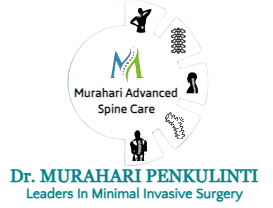Murahari Advanced Spine Center
Cervical Disc Replacement
Cervical Disc Replacement
Disc replacement typically occurs at cervical spine levels C4-5, C5-6, or C6-7. The first seven vertebrae make up the cervical spine. Doctors often refer to these vertebrae as C1 to C7. The cervical spine starts where the top vertebra (C1) connects to the bottom of the skull. The cervical spine curves slightly inward and ends where C7 joins the top of the thoracic spine (the chest area) at the first thoracic vertebra, T1.

Each vertebra is made of the same parts. The main section of each cervical vertebra, from C2 to C7, is formed by a round block of bone called the vertebral body. A bony ring attaches to the back of the vertebral body. This ring has two parts. Two pedicles connect directly to the back of the vertebral body. Two lamina bones join the pedicles to complete the ring. The lamina bones form the outer rim of the bony ring. When the vertebrae are stacked on top of each other, the bony rings form a hollow tube that surrounds the spinal cord. The laminae provide a protective wall around the spinal cord.
Cervical disc replacement surgery One level involves removing a diseased cervical disc and replacing it with an artificial disk. It is done when the space between your vertebrae has become too narrow and part of your vertebrae or your cervical disc is pressing on your spinal cord or spinal nerves, causing you pain, numbness, or weakness. When these symptoms do not respond to nonsurgical types of treatment, disc surgery may be recommended. Cervical Disc Replacement The one-level procedure involves the removal and replacement of one level (one disc).
Spinal discs are small cushions between the vertebrae, or spine. They assist in the movement and flexibility of the spinal column. Due to ageing or accident trauma, the spinal discs can weaken and tear. When this occurs, an individual is said to have degenerative disc disease. In the event that a portion of their disc bulges and pinches a nerve or the spinal cord, they may be diagnosed with a herniated disc that leads to severe pain as well as weakness or tingling in their arms.
In order to minimise pain and restore mobility, a spine surgeon may insert an artificial implant into the cervical spine or neck area in order to replace the damaged disc. This minimally invasive procedure that does not involve excising the muscles and soft tissues is referred to as a cervical disc replacement.
It allows a patient to move their neck more naturally and is often an alternative to a spinal fusion, which is a procedure in which two vertebrae are mended into one. Surgeons will only recommend a cervical disc replacement when conservative treatments such as pain medication, steroid injections, and physical therapy have not been effective.
